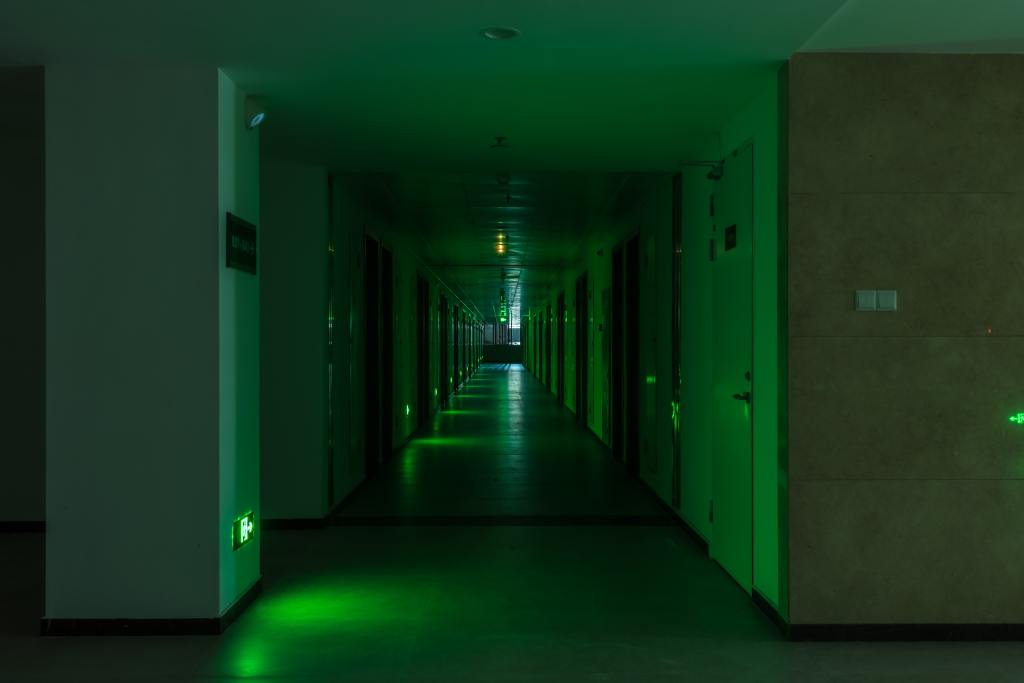Liminal spaces are those weird, atmospheric, and sometimes-eerie places that look like the gateway to another realm.

The place where you find yourself now is so vast, empty of any presence… as if everything there was set there just for you. You might feel free to do as you please or finally find serenity outside the constant hubbub of modern life. Take a dip in this massive body of water; after all, why not? You could do all that, but something is wrong, and you can’t put your finger on it. A strange longing feeling comes over you. Everything seems so familiar, but you have no recollections and memories of being there. Something about this place also reminds you of beautiful things you experienced in your past, good memories that make you smile slightly. However, these beautiful things are no more; the laughter and voices of loved ones give way to silence. Only loneliness remains with the muffled sound of a breeze and the hum of a sizzling neon sign. You are alone. The shadows of the few objects left in this space draw cold silhouettes, like mute spectators staring intently at you in your growing anguish. The light is clear, too pure, you are not supposed to feel fear, but you feel its symptoms. Your throat is tight, your chest constricted, and your breathing is heavy. It resonates within you. The same question has been running through your mind ever since you got here.
“Where am I?”
Liminal spaces. Are you familiar with this word? You probably haven’t heard of it in your life because the term, both obscure and contemplative, only appeared on the Internet for the first time in 2019. On May 12, 2019, to be exact. An anonymous user shares his post with disturbing images that feel ‘ off’ in the deep end of the 4chan forum topics in the /x/ paranormal category. Far from going unnoticed by other platform users, the post is then relayed on the Reddit r/LiminalSpace page. It is from this moment that the phenomenon gains in popularity and interest. A series of strangely familiar videos with scary music appear in the YouTube recommendations of enthusiasts of bizarre happenings. A hash tag #LiminalSpaces is born on Twitter and Tiktok. Publications with this hash tag accumulated more than 16 million views in May 2021. They now have over 35 million views.
But first of all, it would be wise to know what a liminal space is and how to define these extraordinary places, which manage to fascinate an audience of this scale. The basic principle is not as complicated as it seems. A simple Google search will give you hundreds of results which will lead you to the Latin root of the word; limen, which translates as ‘threshold.’ A liminal space is thus the moment between “what was” and “what is to come.” It is the “crossing over” area – a space where you have left something behind, yet you are not yet entirely in something else. It’s a transition space.
All the photos and videos you will find on the subject ultimately hold the same codes. Not a single human or animal is present in these images in vast places, empty. They represent urban places (you won’t find a liminal space without any element related to the presence of humans, a wild forest is not a liminal space, for example), insalubrious places (abandoned car parks, old degraded hotel rooms, …) or sometimes much too neat and tidy (empty airport, hospital corridors, …). And notably incoherent environments: light that is not natural in places where it is not supposed to be, repeated architecture, too identical, doesn’t make sense. The photographs are generally very grainy and of questionable quality, as if they were taken with a film camera or even an old telephone. Hence, one can imagine these images being taken with a very raw, poorly regulated flash. This makes us think that the photo was taken in the dark. The flash takes away the depth of the place, emphasizing the unreal and destabilizing effect of the area. This artificial light in the photos is similar to people’s photos in everyday life, which explains the feeling of familiarity one can feel when observing them.
The fascination of Internet users with the concept can be explained in different ways. Indeed, there are several reasons why liminal spaces have become so popular. First of all, one of the most important elements to highlight when talking about liminal places is the aesthetics of the memory. What captivated many people about these places, apart from the nostalgia and melancholy, was, above all, the fact that (almost) everyone had this strange feeling of déjà vu. How is it possible that someone I don’t know from Adam, or even several people and myself, feel the same emotions when looking at these images? Rooted in the past, the whole aesthetic of these images is created to resemble memories or at least the visual idea that one might have of a memory. As we all know, a memory decays, and the liminal aesthetic also borrows from this effect. Thus, most of these images/videos use codes from childhood (nurseries, theme parks, swimming pools) linked to childhood traumas (being alone in the city at night or in the supermarket,…) and connect with another important element that constitutes the essence of liminal spaces: the aesthetics of dreams.
Concerning our nightmares, too, in trying to reproduce what we see in our dreams that distressing and troubling emotions resurface. The aesthetics of the dream, or nightmare, revives the sense of incoherence I mentioned earlier. Moreover, the total absence of a person allows us to better identify with the image. It is much easier to remember a repetitive and straightforward place than a face. With a person, the aspect of loneliness disappears. The photo is taken from the first-person point of view as if we had wandered into the wrong place. As if we were in a dream.

And finally, in a more pragmatic way, the discomfort felt when we look at these images can be explained by science. Indeed, our brain is a context machine (thesis from Danko Nikolic). By taking away this context, the why of those things that are as they are, a vast dissonance between what we see and what is supposed to be is created. Therefore, a dissonance that animates a sense of confusion, of unease.
However, I should point out that these images do not necessarily work every time for an apparent reason: from a European’s point of view, Americans make most of these images. Yet, if you are from an Eastern European country, you will be able to find this same type of content adapted to your country’s architectural and cultural characteristics! So there is also a cultural factor to consider (e.g., deserted gas stations that look like American gas stations, diners, old roadside motels, or other typically American places that don’t resonate with our European memories, hence the ineffectiveness of some images.
It is essential to consider that the concept of liminal space is more an aesthetic than a genuinely terrifying feature. To caricature it could even be said that it is only about empty places. Empty places that are not necessarily frightening but relatively calm or even peaceful. However, it is entirely possible to see the concept used as such in horror content. So to close this article, I highly recommend watching the short film The Backrooms Found Footage by Kane Pixels which perfectly captures the feeling of infinity and anguish that liminal places bring.
And which will also lead you to the world of backrooms, an urban legend created by thrill-seeking Internet users. So what do you think? What feelings do you get from Liminal Spaces?
Carole Alibert

Leave a comment